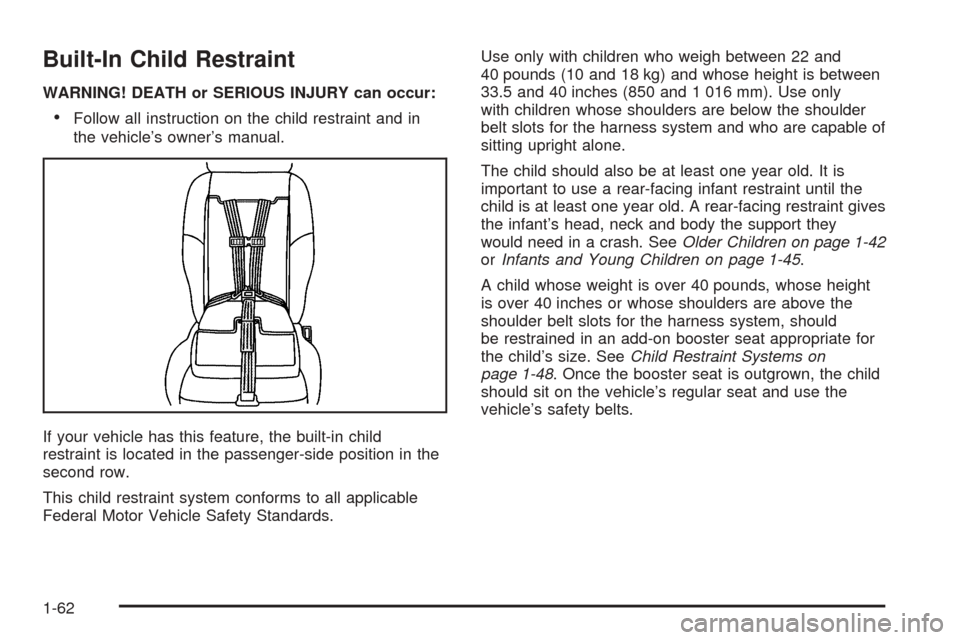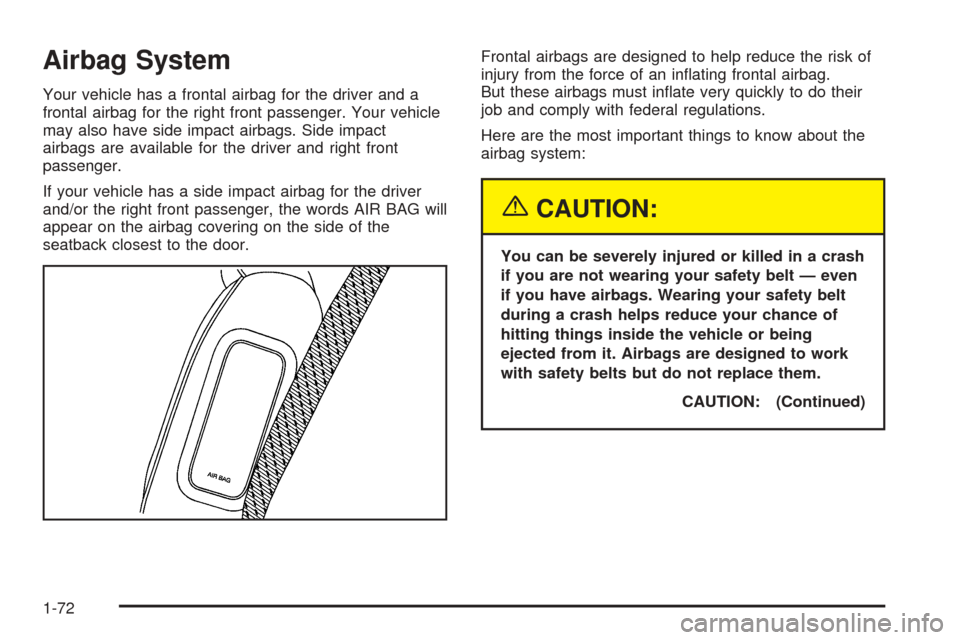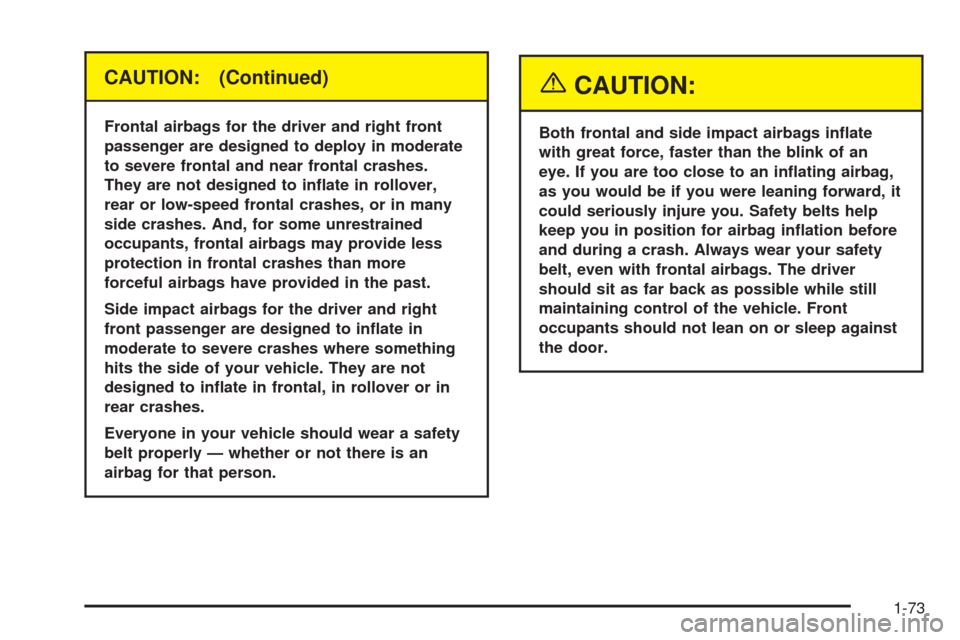Page 67 of 460

6. To tighten the belt, push down on the child restraint,
pull the shoulder portion of the belt to tighten the
lap portion of the belt and feed the shoulder
belt back into the retractor. If you are using a
forward-facing child restraint, you may �nd it helpful
to use your knee to push down on the child
restraint as you tighten the belt. You should not be
able to pull more of the belt from the retractor
once the lock has been set.7. Push and pull the child restraint in different
directions to be sure it is secure.
8. If the airbag or airbags are off, the off indicator on
the instrument panel will be lit and stay lit when the
key is turned to RUN or START.
If a child restraint has been installed and the on
indicator is lit, turn the vehicle off. Remove the child
restraint from the vehicle and reinstall the child restraint.
If after reinstalling the child restraint and restarting
the vehicle, the on indicator is still lit, check to make
sure that the vehicle’s seatback is not pressing the child
restraint into the seat cushion. If this happens, slightly
recline the vehicle’s seatback and adjust the seat
cushion if possible. Also make sure the child restraint is
not trapped under the vehicle head restraint. If this
happens, adjust the head restraint.
If the on indicator is still lit, secure the child in the child
restraint in a rear seat position in the vehicle and
check with your dealer.
To remove the child restraint, just unbuckle the vehicle’s
safety belt and let it go back all the way. The safety
belt will move freely again and be ready to work for an
adult or larger child passenger.
1-61
Page 68 of 460

Built-In Child Restraint
WARNING! DEATH or SERIOUS INJURY can occur:
Follow all instruction on the child restraint and in
the vehicle’s owner’s manual.
If your vehicle has this feature, the built-in child
restraint is located in the passenger-side position in the
second row.
This child restraint system conforms to all applicable
Federal Motor Vehicle Safety Standards.Use only with children who weigh between 22 and
40 pounds (10 and 18 kg) and whose height is between
33.5 and 40 inches (850 and 1 016 mm). Use only
with children whose shoulders are below the shoulder
belt slots for the harness system and who are capable of
sitting upright alone.
The child should also be at least one year old. It is
important to use a rear-facing infant restraint until the
child is at least one year old. A rear-facing restraint gives
the infant’s head, neck and body the support they
would need in a crash. SeeOlder Children on page 1-42
orInfants and Young Children on page 1-45.
A child whose weight is over 40 pounds, whose height
is over 40 inches or whose shoulders are above the
shoulder belt slots for the harness system, should
be restrained in an add-on booster seat appropriate for
the child’s size. SeeChild Restraint Systems on
page 1-48. Once the booster seat is outgrown, the child
should sit on the vehicle’s regular seat and use the
vehicle’s safety belts.
1-62
Page 69 of 460
{CAUTION:
Using the vehicle’s built-in child restraint as a
booster seat for a larger child could cause
injury to the child in a sudden stop or crash. A
child whose weight is over 40 pounds, whose
height is over 40 inches or whose shoulders
are above the shoulder belt slots for the
harness system should use a restraint system
that is appropriate for their size, either an
add-on booster seat or the vehicle’s safety
belt. See “Child Restraints” or “Older
Children” in the Index.
Securing a Child in the Built-In Child
Restraint
1. Raise the head restraint until the lower edge of the
head restraint is even with the top of the seatback.
1-63
Page 71 of 460
You will be using the child restraint’s harness (A) to
secure your child. Do not use the vehicle’s
safety belts.
{CAUTION:
Using the vehicle’s regular safety belts on a
child seated on the built-in child restraint
cushion can cause serious injury to the child
in a sudden stop or crash. Secure the child
using the built-in child restraint’s harness.WARNING:FAILURE TO FOLLOW THE
MANUFACTURER’S INSTRUCTIONS ON THE USE
OF THIS CHILD RESTRAINT SYSTEM CAN RESULT
IN YOUR CHILD STRIKING THE VEHICLE’S
INTERIOR DURING A SUDDEN STOP OR CRASH.
SNUGLY ADJUST THE BELTS PROVIDED WITH THIS
CHILD RESTRAINT AROUND YOUR CHILD.
4. Before placing the child in the child restraint, add
slack to the shoulder harness. Pull the black
shoulder harness release strap �rmly. At the same
time pull both shoulder harness straps through
the slots in the seatback as shown.
5. Place the child on the child restraint cushion.
1-65
Page 76 of 460
Storing the Built-In Child Restraint
Always properly store the built-in child restraint before
using the vehicle’s lap-shoulder belt.
1. Move both latch plates and both sides of the
shoulder harness clip to the bottom of the harness
straps.2. Fold the child restraint cushion and leg rest up into
the seatback.
3. Press the child restraint cushion �rmly into the
seatback.
1-70
Page 78 of 460

Airbag System
Your vehicle has a frontal airbag for the driver and a
frontal airbag for the right front passenger. Your vehicle
may also have side impact airbags. Side impact
airbags are available for the driver and right front
passenger.
If your vehicle has a side impact airbag for the driver
and/or the right front passenger, the words AIR BAG will
appear on the airbag covering on the side of the
seatback closest to the door.Frontal airbags are designed to help reduce the risk of
injury from the force of an in�ating frontal airbag.
But these airbags must in�ate very quickly to do their
job and comply with federal regulations.
Here are the most important things to know about the
airbag system:
{CAUTION:
You can be severely injured or killed in a crash
if you are not wearing your safety belt — even
if you have airbags. Wearing your safety belt
during a crash helps reduce your chance of
hitting things inside the vehicle or being
ejected from it. Airbags are designed to work
with safety belts but do not replace them.
CAUTION: (Continued)
1-72
Page 79 of 460

CAUTION: (Continued)
Frontal airbags for the driver and right front
passenger are designed to deploy in moderate
to severe frontal and near frontal crashes.
They are not designed to in�ate in rollover,
rear or low-speed frontal crashes, or in many
side crashes. And, for some unrestrained
occupants, frontal airbags may provide less
protection in frontal crashes than more
forceful airbags have provided in the past.
Side impact airbags for the driver and right
front passenger are designed to in�ate in
moderate to severe crashes where something
hits the side of your vehicle. They are not
designed to in�ate in frontal, in rollover or in
rear crashes.
Everyone in your vehicle should wear a safety
belt properly — whether or not there is an
airbag for that person.
{CAUTION:
Both frontal and side impact airbags in�ate
with great force, faster than the blink of an
eye. If you are too close to an in�ating airbag,
as you would be if you were leaning forward, it
could seriously injure you. Safety belts help
keep you in position for airbag in�ation before
and during a crash. Always wear your safety
belt, even with frontal airbags. The driver
should sit as far back as possible while still
maintaining control of the vehicle. Front
occupants should not lean on or sleep against
the door.
1-73
Page 80 of 460
{CAUTION:
Anyone who is up against, or very close to,
any airbag when it in�ates can be seriously
injured or killed. Airbags plus lap-shoulder
belts offer the best protection for adults, but
not for young children and infants. Neither the
vehicle’s safety belt system nor its airbag
system is designed for them. Young children
and infants need the protection that a child
restraint system can provide. Always secure
children properly in your vehicle. To read how,
seeOlder Children on page 1-42orInfants and
Young Children on page 1-45.
There is an airbag
readiness light on the
instrument panel cluster,
which shows the airbag
symbol.The system checks the airbag electrical system for
malfunctions. The light tells you if there is an electrical
problem. SeeAirbag Readiness Light on page 3-34
for more information.
Where Are the Airbags?
The driver’s frontal airbag is in the middle of the
steering wheel.
1-74